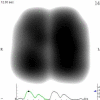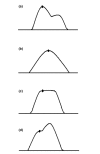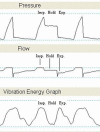Regional distribution of acoustic-based lung vibration as a function of mechanical ventilation mode
- PMID: 17316449
- PMCID: PMC2151859
- DOI: 10.1186/cc5706
Regional distribution of acoustic-based lung vibration as a function of mechanical ventilation mode
Abstract
Introduction: There are several ventilator modes that are used for maintenance mechanical ventilation but no conclusive evidence that one mode of ventilation is better than another. Vibration response imaging is a novel bedside imaging technique that displays vibration energy of lung sounds generated during the respiratory cycle as a real-time structural and functional image of the respiration process. In this study, we objectively evaluated the differences in regional lung vibration during different modes of mechanical ventilation by means of this new technology.
Methods: Vibration response imaging was performed on 38 patients on assist volume control, assist pressure control, and pressure support modes of mechanical ventilation with constant tidal volumes. Images and vibration intensities of three lung regions at maximal inspiration were analyzed.
Results: There was a significant increase in overall geographical area (p < 0.001) and vibration intensity (p < 0.02) in pressure control and pressure support (greatest in pressure support), compared to volume control, when each patient served as his or her own control while targeting the same tidal volume in each mode. This increase in geographical area and vibration intensity occurred primarily in the lower lung regions. The relative percentage increases were 28.5% from volume control to pressure support and 18.8% from volume control to pressure control (p < 0.05). Concomitantly, the areas of the image in the middle lung regions decreased by 3.6% from volume control to pressure support and by 3.7% from volume control to pressure control (p < 0.05). In addition, analysis of regional vibration intensity showed a 35.5% relative percentage increase in the lower region with pressure support versus volume control (p < 0.05).
Conclusion: Pressure support and (to a lesser extent) pressure control modes cause a shift of vibration toward lower lung regions compared to volume control when tidal volumes are held constant. Better patient synchronization with the ventilator, greater downward movement of the diaphragm, and decelerating flow waveform are potential physiologic explanations for the redistribution of vibration energy to lower lung regions in pressure-targeted modes of mechanical ventilation.
Figures









References
-
- Gluck E, Sarrigianidis A, Dellinger RP. Mechanical ventilation. In: Parrillo JE, Dellinger RP, editor. Critical Care Medicine: Principles of Diagnosis and Management in the Adult. 2. St. Louis: Mosby; 2001. pp. 137–161.
-
- Esteban A, Hanzueto A, Alia I, et al. How is mechanical ventilation employed in the intensive care unit? An international utilization review. Am J Respir Crit Care Med. 2000;161:1450–1458. - PubMed
-
- Campbell RS, Davis BR. Pressure-controlled versus volume-controlled ventilation: does it matter? Respir Care. 2002;47:416–424. - PubMed
Publication types
MeSH terms
LinkOut - more resources
Full Text Sources
Other Literature Sources
Medical
Molecular Biology Databases

